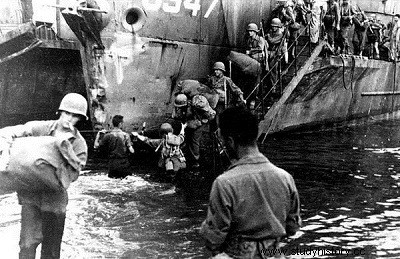
The only valuable German troop present in the region belonged to the XI Panzer Gespent (“Ghost” division) stationed in the Toulouse-Carcassonne-Albi triangle. But for General Walther Botsch (Chief of Staff of the XIX Army), the value of the Panzers was questionable. Like all the other armored units of the Wehrmacht, they were under the direct orders of Adolf Hitler whose power of decision, on whose speed one could not count, had been further reduced by the attempted attack of July 20, 1944. General Botsch actually commanded only 6 or 7 second-rate divisions, of low operational value, made up of wounded and war-weary veterans, survivors from other theaters of operations, as well as former Russian prisoners. and Poles you couldn't count on. It was practically
all that was left in Provence. Valuable troops had been sent to Normandy to help stem the Allied tide:four full infantry divisions, the bulk of two others, two panzer divisions, and all but 200 aircraft. As Churchill later pointed out, it seems that it was 'Overlord' who helped 'Dragoon', and not the other way around.
In late July and early August 1944, while As nearly 1,000 ships, more than 5,000 aircraft and some 200,000 men assembled, Mediterranean ports and waters bustled with activity. Naples, Brindisi, Oran and Corsica were swarming with troops about to board 500 transports. The Allied invasion fleet, protected by 6 battleships, 21 cruisers, 100 destroyers and 9 aircraft carriers, concentrated in the western Mediterranean and the bulk of the Allied aviation — over 2,100 aircraft — gathered at 14 airfields in Corsica.
It was this powerful air component, comprising 37 U.S. Air Force (B-25, A-20, P-38 and P-47), 11 R.A.F. and four French fighter squadrons, which dealt the first blows to the enemy defenses around, behind and directly on the part of the coast chosen for the landing. The aerial attack, dubbed Operation Nutmeg, began on April 28, was reinforced on August 4, and continued until around 3:30 p.m. on the day of the landing. During these 15 weeks, the Allied air force sprayed the docks, port facilities, railways, roads, bridges, wharfs for submarines, radar stations, airfields, artillery batteries, fortifications and any site likely to contribute to the defense of Provence by the Germans. More than 12,000 tons of bombs were dropped during
10,000 raids.
During the August 7 raid, the 310 kilometers of coastline between Nice and Montpellier were attacked by 300 bombers. During that of August 11, it was the turn of all the radar stations on the Mediterranean coast. During the two raids on August 6 and
11, Toulon received a total of 560 tons of bombs which sank four of the eight German submarines anchored there.
